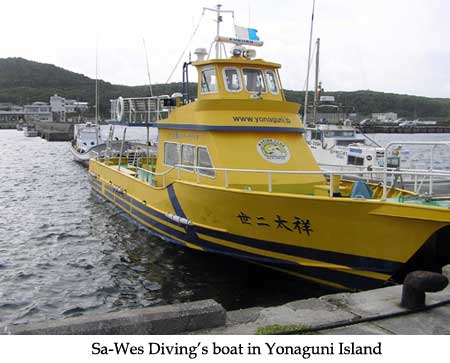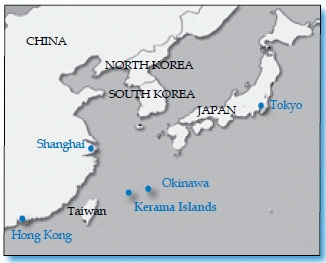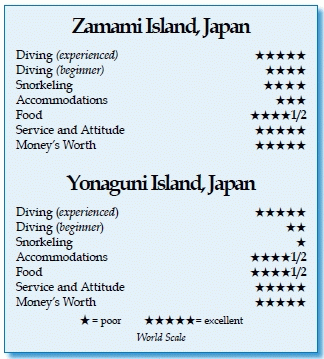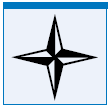Kerama Islands, JapanContents of this Issue: Solmar V, Baja California, Mexico Manslaughter in Australia, An Acquittal in Alabama Thumbs Down: DiveNav’s Fake Nitrox Class Cape Eleuthera, Fiji, Maui, Mexico The “Discover Scuba Diving” Programs Flying After Diving: A Threat Worse than the Bends A New Travel-Friendly Fish ID Book for Caribbean Dive Trips When Crew Disrespects Your Gear Editorial Office: Ben Davison Publisher and Editor Undercurrent 3020 Bridgeway, Suite 102 Sausalito, CA 94965 exotic, challenging dives between Okinawa and Taiwan from the March, 2012 issue of Undercurrent
From time to time, we get such unique reports from readers, we feel compelled to share them with you, recognizing that few divers -- and that includes me - - will ever travel there. However, diving in southern Japan is intriguing, and even more so when we read what our undercover reporter, who has been just about everywhere, has to say. -- Ben Davison Dear Fellow Diver: It was my second trip diving on the island of Zamami last September, and I was just as impressed this time as last. After a high-speed ferry from Okinawa, 25 miles away, my buddy and I were greeted by Momo, premier divemaster at Heartland Dive Shop. Dive sites were selected based on the currents and waves, so we had easy diving with 150-foot visibility and no current in 81-degree water.
A thousand miles southwest from Tokyo, Zamami is part of the Kerama Islands, with a population under 1,000 and a popular destination for Japanese divers. We arrived on the day of the celebration of the Ocean God. Although I had no sake as a gift for the Shrine, I eagerly went with Momo, joining the entire community as they told stories, and the elders sang traditional songs and danced. Each guest was given fried fish, fruit, and rice; beer was plentiful. The community caught 750 fish the day before, and the old women fried it (one reason for the scarcity of big fish). Japan is a very homogeneous society, with very few foreigners. However, visitors will be pleasantly surprised that many places in tourist areas will have signs in English, and there is always someone who knows enough English to help you find your way. My dive buddy and I were on our own, with only a dozen Japanese words between us, but we did fine. The next destination was Yonaguni, the furthermost island of the Kerama Islands and only 60 miles from Taiwan. One ferry ride and two flights later, we arrived, were served lunch by Sa-Wes Diving in its hotel's dining room, and then were quickly on the 60-foot dive boat with twin 320hp engines for two afternoon dives. High waves were rolling from a couple of directions, current was strong and the surge nothing to snicker at. But I came here to see the Yonaguni Monument -- an underwater rock formation that no one is sure if it's natural or man-made -- and that I did, but not without doing exhausting dives. Before coming here, one should have dozens of dives in strong three-knot-plus currents, and experience with big surge. Equally important is being fit. I used every bit of my energy and skills, and I enjoyed every moment. Unfortunately, my dive buddy did not fare as well -- her poor fitness level contributed to her missing half the dives.
Still, those two days of diving were awe-inspiring. Some people think the Yonaguni Monument is an artificial, or artificially modified, structure built 2,500 years ago. Is it a lost city? I came to Yonaguni a doubter and left a believer. What convinced me were the sculpted "pyramid" stairs, steps leading up from a confined passageway, hieroglyphic- type writings on the walls which looked hand-hewn and very similar to other ancient writings I saw on an island stone. As I looked at the cliff walls, it was easy to imagine faces, similar to Mt. Rushmore. One in particular had eyes that contained pupils. The archway was impressive, as were the huge booms from waves hitting the rocks above. Interesting photos are at www.pbase.com/the_underwater_world/yonaguni I can well imagine Sa-Wes Diving founder Kihachiro Aratake's amazement in 1985 when he came upon these ruins while looking for dive sites. I was fortunate to have him serve as boat captain, and I got a first-class tour with my 11 dives. A young Japanese couple on board with me had just finished their Advanced certification, so Aratake found less turbulent dive sites for the next two days, with almost no current in the 83-degree water. Instead of the current-polished bedrock, I was treated to total bommie coral coverage with many colorful tropical fish, nudibranchs, tunnels and caverns. Sa-Wes Diving provided transportation to the dive operation each day, and arranged a horseback-riding tour on indigenous Yonaguni horses and an extensive tour of the island. They had a last-night party that defies description in the variety of sake, excellent wine, and interesting foods prepared by Aratake himself, including pig's tongue and dried squid in threads. All this was accompanied by ingenious karaoke, drumming, and playing of the traditional sanshin, a three-string, banjo-type instrument of the region. The Ailand Resort, a new, nicely appointed, Western-style hotel, accommodated us very well. It offered large rooms, outdoor pool, bathhouse and a very good buffet restaurant offering a variety of western and Japanese dishes. The sashimi was excellent and fortunately, one of the dozen staff members spoke English very well. My trip was arranged by Lisa Slater from Open Coast Travel. As a former dive instructor, Lisa spent years diving in Japan, and knows the ins and outs of traveling within the country and the best dive operators to use. It is an expensive trip, but if you are up for something different and diving you will never forget, consider Japan's southern Kerala Islands chain. I've dived all over the world, and consider Zamami and Yonaguni among the top three diving adventures I have had. -- J.D.
|

I want to get all the stories! Tell me how I can become an Undercurrent Online Member and get online access to all the articles of Undercurrent as well as thousands of first hand reports on dive operations world-wide
| Home | Online Members Area | My Account |
Login
|
Join
|
| Travel Index |
Dive Resort & Liveaboard Reviews
|
Featured Reports
|
Recent
Issues
|
Back Issues
|
|
Dive Gear
Index
|
Health/Safety Index
|
Environment & Misc.
Index
|
Seasonal Planner
|
Blogs
|
Free Articles
|
Book Picks
|
News
|
|
Special Offers
|
RSS
|
FAQ
|
About Us
|
Contact Us
|
Links
|
3020 Bridgeway, Ste 102, Sausalito, Ca 94965
All rights reserved.

 The checkout dive was not ho-hum, as the first thing I saw was a rockmover wrasse
in hunting mode, and a baby wrasse measuring
a quarter-inch erratically skirting along
in the sand. Too early for the humpback whales
to return to these waters to give birth, but
Zamami's undersea world was still alive with
colorful fish, although no big ones. Sleeping
black-headed sea snakes could be awoken from
their communal slumber with a gentle tail tweak,
and the golden cuttlefish languidly posed while
we took in its nuances. On the same dive, a
group of squid treated us to their color transformations.
Brilliant blue and red 15-inch sea
stars could be seen on all dives, but the one
that most captured my attention was a quarterinch-
long red miniature. Three feet away, an inch-long cryptic comet star hung from
coral by a "thread." Juvenile three-spot
dascyllus darted about with the half-dozen
species of anemonefish. There were many
sweetlips, but my favorite was the juvenile
many-spotted mimicking a toxic flat worm.
There were the usual suspects, seen on most
dives in the tropical Pacific, and then the
just esoteric enough that I wondered if it
were another species.
The checkout dive was not ho-hum, as the first thing I saw was a rockmover wrasse
in hunting mode, and a baby wrasse measuring
a quarter-inch erratically skirting along
in the sand. Too early for the humpback whales
to return to these waters to give birth, but
Zamami's undersea world was still alive with
colorful fish, although no big ones. Sleeping
black-headed sea snakes could be awoken from
their communal slumber with a gentle tail tweak,
and the golden cuttlefish languidly posed while
we took in its nuances. On the same dive, a
group of squid treated us to their color transformations.
Brilliant blue and red 15-inch sea
stars could be seen on all dives, but the one
that most captured my attention was a quarterinch-
long red miniature. Three feet away, an inch-long cryptic comet star hung from
coral by a "thread." Juvenile three-spot
dascyllus darted about with the half-dozen
species of anemonefish. There were many
sweetlips, but my favorite was the juvenile
many-spotted mimicking a toxic flat worm.
There were the usual suspects, seen on most
dives in the tropical Pacific, and then the
just esoteric enough that I wondered if it
were another species. My dive buddy and I each had our
own western-style rooms at the Miyamura
Pension. It was super clean, with air
conditioning, fridge, and a small balcony
to hang stuff to dry. Trying to figure
out which was shampoo and which body
soap was challenging, as it was written in
Kanji. Such language challenges were common
throughout this trip. Within the same block was the restaurant where we were served
set meals; sashimi, rice, and soup graced both breakfast and lunch. The dive shop was
within steps of the restaurant and hotel. Fresh fruit ices were sold across from the
bench where we put on our wetsuits before being driven to the dive boat. After the
afternoon dive, I scarfed them down as quickly as their coldness permitted.
My dive buddy and I each had our
own western-style rooms at the Miyamura
Pension. It was super clean, with air
conditioning, fridge, and a small balcony
to hang stuff to dry. Trying to figure
out which was shampoo and which body
soap was challenging, as it was written in
Kanji. Such language challenges were common
throughout this trip. Within the same block was the restaurant where we were served
set meals; sashimi, rice, and soup graced both breakfast and lunch. The dive shop was
within steps of the restaurant and hotel. Fresh fruit ices were sold across from the
bench where we put on our wetsuits before being driven to the dive boat. After the
afternoon dive, I scarfed them down as quickly as their coldness permitted. The next day, I was the only diver
on the boat for two very tough dives.
The divemaster spoke little English --
my instructions were, "Go to 80 feet and
hold on." When I spotted him underwater,
he was 20 feet ahead of me, finning
hard into the strong current. I found
myself with nothing to hold onto until
huge slabs of bedrock at 104 feet. After
two athletic dives at 100-plus feet, I
called uncle before a third, not wanting
to take a chance of DCS.
The next day, I was the only diver
on the boat for two very tough dives.
The divemaster spoke little English --
my instructions were, "Go to 80 feet and
hold on." When I spotted him underwater,
he was 20 feet ahead of me, finning
hard into the strong current. I found
myself with nothing to hold onto until
huge slabs of bedrock at 104 feet. After
two athletic dives at 100-plus feet, I
called uncle before a third, not wanting
to take a chance of DCS. Divers Compass: A United Airlines flight from Los Angeles to Tokyo's
Haneda airport currently averages $875 . . . My package price of
$4,250 included: round trip flights to Tokyo-Okinawa-Yonaguni; 13
nights' accommodation in Tokyo, Zamami and Yonaguni; ground transfers
in Zamami and Yonaguni; eight boat dives in Zamami and 11 boat dives
in Yonaguni; and tanks, weights, and surcharges . . . Breakfast and
dinner were included in Zamami; in Yonaguni, breakfast was included at
the resort, lunch provided by Sa-Wes Diving, and dinner was on our own,
as were meals in Tokyo . . . Getting to the ferry from the Okinawa
airport and round-trip ferry rides to Zamami was out-of-pocket . . . Food everywhere
was excellent, but you have to like fresh fish and sashimi to appreciate it; alternatives
were available, however . . . It is not custom to tip in Japan; instead, I honored
their omiyage tradition of gifts, and they reciprocate -- a great system . . . To
book a similar trip, I recommend Lisa at Open Coast Travel (
Divers Compass: A United Airlines flight from Los Angeles to Tokyo's
Haneda airport currently averages $875 . . . My package price of
$4,250 included: round trip flights to Tokyo-Okinawa-Yonaguni; 13
nights' accommodation in Tokyo, Zamami and Yonaguni; ground transfers
in Zamami and Yonaguni; eight boat dives in Zamami and 11 boat dives
in Yonaguni; and tanks, weights, and surcharges . . . Breakfast and
dinner were included in Zamami; in Yonaguni, breakfast was included at
the resort, lunch provided by Sa-Wes Diving, and dinner was on our own,
as were meals in Tokyo . . . Getting to the ferry from the Okinawa
airport and round-trip ferry rides to Zamami was out-of-pocket . . . Food everywhere
was excellent, but you have to like fresh fish and sashimi to appreciate it; alternatives
were available, however . . . It is not custom to tip in Japan; instead, I honored
their omiyage tradition of gifts, and they reciprocate -- a great system . . . To
book a similar trip, I recommend Lisa at Open Coast Travel ( 